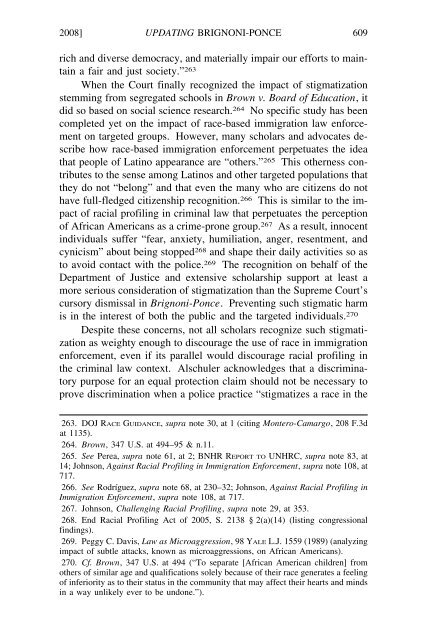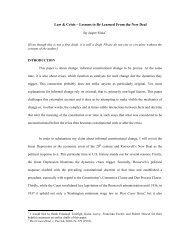updating brignoni-ponce - New York University School of Law
updating brignoni-ponce - New York University School of Law
updating brignoni-ponce - New York University School of Law
You also want an ePaper? Increase the reach of your titles
YUMPU automatically turns print PDFs into web optimized ePapers that Google loves.
2008] UPDATING BRIGNONI-PONCE 609<br />
rich and diverse democracy, and materially impair our efforts to maintain<br />
a fair and just society.” 263<br />
When the Court finally recognized the impact <strong>of</strong> stigmatization<br />
stemming from segregated schools in Brown v. Board <strong>of</strong> Education, it<br />
did so based on social science research. 264 No specific study has been<br />
completed yet on the impact <strong>of</strong> race-based immigration law enforcement<br />
on targeted groups. However, many scholars and advocates describe<br />
how race-based immigration enforcement perpetuates the idea<br />
that people <strong>of</strong> Latino appearance are “others.” 265 This otherness contributes<br />
to the sense among Latinos and other targeted populations that<br />
they do not “belong” and that even the many who are citizens do not<br />
have full-fledged citizenship recognition. 266 This is similar to the impact<br />
<strong>of</strong> racial pr<strong>of</strong>iling in criminal law that perpetuates the perception<br />
<strong>of</strong> African Americans as a crime-prone group. 267 As a result, innocent<br />
individuals suffer “fear, anxiety, humiliation, anger, resentment, and<br />
cynicism” about being stopped 268 and shape their daily activities so as<br />
to avoid contact with the police. 269 The recognition on behalf <strong>of</strong> the<br />
Department <strong>of</strong> Justice and extensive scholarship support at least a<br />
more serious consideration <strong>of</strong> stigmatization than the Supreme Court’s<br />
cursory dismissal in Brignoni-Ponce. Preventing such stigmatic harm<br />
is in the interest <strong>of</strong> both the public and the targeted individuals. 270<br />
Despite these concerns, not all scholars recognize such stigmatization<br />
as weighty enough to discourage the use <strong>of</strong> race in immigration<br />
enforcement, even if its parallel would discourage racial pr<strong>of</strong>iling in<br />
the criminal law context. Alschuler acknowledges that a discriminatory<br />
purpose for an equal protection claim should not be necessary to<br />
prove discrimination when a police practice “stigmatizes a race in the<br />
263. DOJ RACE GUIDANCE, supra note 30, at 1 (citing Montero-Camargo, 208 F.3d R<br />
at 1135).<br />
264. Brown, 347 U.S. at 494–95 & n.11.<br />
265. See Perea, supra note 61, at 2; BNHR REPORT TO UNHRC, supra note 83, at R<br />
14; Johnson, Against Racial Pr<strong>of</strong>iling in Immigration Enforcement, supra note 108, at R<br />
717.<br />
266. See Rodríguez, supra note 68, at 230–32; Johnson, Against Racial Pr<strong>of</strong>iling in R<br />
Immigration Enforcement, supra note 108, at 717. R<br />
267. Johnson, Challenging Racial Pr<strong>of</strong>iling, supra note 29, at 353. R<br />
268. End Racial Pr<strong>of</strong>iling Act <strong>of</strong> 2005, S. 2138 § 2(a)(14) (listing congressional<br />
findings).<br />
269. Peggy C. Davis, <strong>Law</strong> as Microaggression, 98 YALE L.J. 1559 (1989) (analyzing<br />
impact <strong>of</strong> subtle attacks, known as microaggressions, on African Americans).<br />
270. Cf. Brown, 347 U.S. at 494 (“To separate [African American children] from<br />
others <strong>of</strong> similar age and qualifications solely because <strong>of</strong> their race generates a feeling<br />
<strong>of</strong> inferiority as to their status in the community that may affect their hearts and minds<br />
in a way unlikely ever to be undone.”).
















